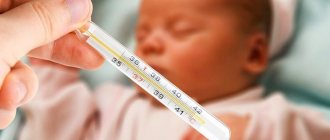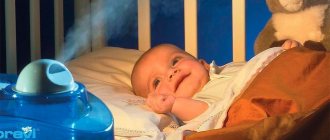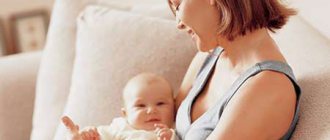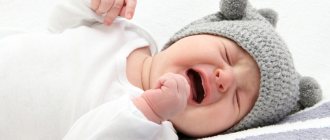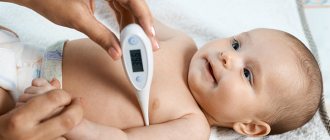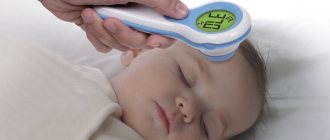Optimal room temperature for babies
Room temperature
It is unlikely that anyone will dispute the opinion of experienced specialists who argue that the room temperature where a newborn baby is located should not be higher than 18-22°C. Under these conditions, the baby breathes easier, eats well, does not overheat, and develops in natural conditions.
In winter, when the heating season begins in the apartment and temperature changes are possible, the permissible threshold should not exceed 23°C.
Temperature for sleeping
The sleep of a newborn baby directly depends on the temperature in the room. In both a cold and hot bedroom, the baby's sleep is superficial. The baby often wakes up, is capricious, and requires constant attention. Parents need to ensure that the children's bedroom has a constant temperature of 18-20°C.
These recommendations cannot be considered an unshakable rule. Each baby is an individual organism with its own characteristics. Some people like to sleep in a warm room, but for others, 18°C is quite a suitable temperature for sleep. Therefore, parents should observe in what conditions the baby sleeps better and try to adhere to them.
A modern newborn bed is equipped with sides and a canopy. These options look beautiful from the outside, and parents think that the baby is cozy and comfortable. Perhaps this is indeed true, but these objects collect dust and do not allow air to circulate normally. Therefore, it is advisable to abandon them.
Bed linen and clothes for the baby should be selected from natural materials. Synthetic products do not allow the skin to breathe, which means that the thermoregulation of the skin is disrupted. The baby doesn't need a hat at all. In a hot room, you should not wrap the baby up; in a cool room, you should not expose the baby.
Bathing
Often, before bathing a newborn child, parents increase the air temperature in the bathing room, heating it in all possible ways. However, this is wrong. If the temperature is high, then under normal conditions the baby will freeze after bathing. To avoid this, special temperature increases are excluded. It is much better to wrap the baby in a warm towel after washing and wait for a certain time. Hardening has a beneficial effect on the baby's body. Therefore, mothers do a very good job of accustoming their baby to air baths after bathing.
If the baby was born prematurely, he needs special conditions. One of them is room temperature. It should be maintained within 24-25°C due to the reduced level of the baby’s own thermoregulation.
Creating optimal conditions
In newborns, the mechanisms of thermoregulation are not yet sufficiently formed. For this reason, there is a risk of overheating or hypothermia of the child’s body.
According to experts, parents, based on this provision, often come to the wrong conclusion, namely, they pay too much attention to protecting the child from hypothermia. For example, when preparing to welcome a baby from the maternity hospital, mom and dad first of all buy an electric heater.
On a note. In the wards where newborns are located, the air temperature is maintained at 22 degrees (usually it is higher). Knowing this, parents strive to ensure that home conditions are as close to hospital conditions as possible. Fearing the cold, mom and dad often forget that the baby’s inability to perfectly control body temperature can cause not only hypothermia, but also overheating.
For children in the maternity hospital, the temperature is maintained at 22 degrees
What temperature should be maintained
The optimal temperature in a room for a newborn varies between 18-22 degrees. According to Dr. Komarovsky, the higher this value, the worse it is for the newborn. Thus, hypothermia is not as dangerous for the baby as overheating.
Most doctors are of the opinion that the ideal room temperature for a newborn is 22 degrees above zero. However, there is an alternative point of view, according to which this indicator is too high, and therefore will interfere with the baby’s ability to harden. In this regard, pediatricians suggest reducing the temperature in the room where the child is located to 19-20 degrees.
On a note. You should not rely on your own sensations caused by the temperature regime, since in adults the mechanisms of thermoregulation differ from those in children.
The above parameters are optimal for healthy full-term infants. If the baby is premature (born prematurely), then special conditions must be created for him. In this case, the room temperature for a newborn should be 24-25 degrees.
Air humidity
The need to control this parameter is explained by the same reason - the imperfection of thermoregulation mechanisms in infants. The temperature of the air that is exhaled is 36.6 degrees, humidity is 100%. The drier the inhaled streams, the more the body is forced to spend fluids to moisturize them, which negatively affects the health of the baby.
Air humidity and temperature can be measured with a special device
Danger of low humidity levels
Most Russian families live in special climatic conditions: there is a heating season for six months (all winter and partly in autumn and spring). The operation of heating systems leads to drying of indoor air. As a result, the parameter is reduced by approximately 2 times. The problem is further aggravated by the fact that household members are concerned about the risk of the child freezing, and therefore contribute to the active heating of the children's room. The air becomes even drier, increasing the risk of health problems. Such conditions can lead to problems such as:
- Weakening of the protective functions of the mucous membranes of the nose and larynx due to their drying out;
- Blood thickening;
- Asthma;
- Allergy;
- Skin problems and more.
That is why it is very important to maintain a comfortable temperature and humidity in the apartment for newborns in winter. The following measures help maintain normal humidity:
- Regular wet cleaning;
- Open containers with water;
- Spraying the room with a spray bottle;
- Installation of decorative fountains;
- Purchasing an aquarium;
- Using a household air humidifier (there are 2 options: steam and ultrasonic).
Risk of overheating and hypothermia
In an infant, metabolic processes that serve to maintain his life occur much faster than in an adult. This entails the accumulation of heat in a small body. The baby can get rid of its excess thanks to the skin and the breathing process. If the room is hot, the baby's breathing will be difficult. There remains heat transfer through the skin. In this case, the child sweats more, the skin turns red, and the pulse quickens. The baby becomes restless, whiny, lethargic. During this period, dermatitis, prickly heat, metabolic disorders, abdominal pain, lack of appetite, and thrush are possible.
If the room of a newborn baby is cool, then the baby may get a cold, and this can lead to complications. Parents, having noticed cold perspiration, trembling and hiccups, pale skin, and rapid breathing in the baby, should understand that these are signs of hypothermia. You should urgently normalize the temperature in the newborn’s room and call a doctor.
By maintaining an optimal temperature in a newborn baby’s room, you can avoid any problems and give the baby a chance to grow and develop calmly.
The dangers of hypothermia
Hypothermia can be no less dangerous for a child. In addition to the inconvenience caused to the baby, when inhaling cold air, a number of negative symptoms appear: the skin turns pale, breathing quickens, and the body trembles. The consequences of hypothermia can be very serious, including fainting. To avoid this condition, it is necessary to warm the baby by holding him close to the body or wrapping him in a warm blanket, and also normalize the level of humidity in the children's room.
Reduced body temperature can lead to exhaustion of the body, changes in the vascular system of the brain, increased skin moisture and a general decrease in the baby’s vitality.
How to maintain room temperature
Each child needs an individual temperature for development and growth. And only observing their own child will help parents decide on its standards. How does a baby behave in comfortable conditions?
- restful sleep;
- good health;
- lack of increased sweating and skin redness;
- pulse, breathing within normal limits;
- absence of goose bumps;
- thermoregulation of the limbs is not impaired.
Look at the thermometer at this moment. This is the optimal room temperature for a child. Remember and maintain it regularly.
If there are large deviations from the norm in one direction or another, take measures to regulate the temperature in the room.
What can you do if the room is hot?
- Ventilation or air conditioning will help. These procedures are performed in the absence of the baby. Take him to another part of the house, or better yet, take him for a walk in the open air.
- The air conditioner should not be installed in the nursery. Let it be in another room. A newborn baby should not be exposed to a stream of cool air.
- Cover hot radiators with thick items, be it a blanket or a rug.
- The intervals between feedings can be reduced if the baby is hot in the room. Whether this will have an effect, the answer is clear. Mother's milk consists of 80% water, so it quenches thirst and regulates fluid levels in the body. If the baby is on artificial nutrition, it is supplemented with water at room temperature.
- If the room is cool, a heater comes to the rescue. But the device dries the air, which can lead to dryness in the baby’s nose, which will reduce the body’s ability to fight germs. When using the device, humidify the air.
There is no way to control the temperature in the room
Not every family can provide a newborn child with a separate room or air conditioning. But every parent dreams of raising a healthy child and creating relatively comfortable living conditions for him. What to do in conditions when it is impossible to control the temperature in the room for a newborn baby. Follow these tips:
- if the apartment is hot and stuffy, increase the amount of liquid your baby consumes;
- dress according to the temperature: it’s hot - panties, a T-shirt with thin straps or without it at all; cool - rompers, socks, vest;
- bathe according to the temperature regime: hot - several times a day; cool - at the discretion of the parents.
Why is the temperature regime in the nursery so important?
Many conditions of the human body depend on the conditions of its environment.
For example, if you are in a stuffy or cold room, this is, at best, limited to discomfort, and at worst, pathological conditions may develop (fainting, colds, etc.). The small organism spent nine months in comfortable conditions, where stable humidity and temperature were maintained. Having entered this world, the baby received stress with a change in his usual conditions. The task of adults is to make it easier for the little person to adapt to a new life. If we neglect the temperature regime, the baby may experience a number of conditions associated with thermoregulation disorders.
Air humidity
As mentioned above, intense loss of moisture in a child’s body can occur due to breathing at low air humidity. Considering the fact that most of our population lives in climatic conditions where the heating system operates indoors for almost half a year, leading to drying out the air, this problem is very relevant. What should the humidity be in order to eliminate this negative process - loss of moisture from the body?
Humidity between 50 and 70 percent is considered optimal. To monitor it, you can purchase a household hygrometer, which comes in several types. Digital and arrow symbols are more common. Their prices also vary, but you can find them at a very affordable price.
But control alone is not enough. Tools or devices are needed to create and maintain optimal climatic conditions in the room. Therefore, if your heating works normally during the cold season, there is no need to buy additional heaters. It's better to buy a humidifier. They come in steam and ultrasonic types. The latter are safer and quieter, but their price is slightly higher. Some models have a built-in hygrometer, eliminating the need to purchase one separately.
If the possibility of such a purchase is not available, a number of measures can be taken to improve the climate by other methods. One of these is the aquarium. You can also place wide containers filled with water. In these cases, humidification will occur due to natural evaporation of water. You can periodically use spray bottles filled with water (as a last resort) or hang wet towels on the radiators and change them regularly when dry.
Another solution could be decorative indoor fountains and frequent wet cleaning. Of course, these are half measures and only a humidifier can completely solve the problem of maintaining optimal humidity.

